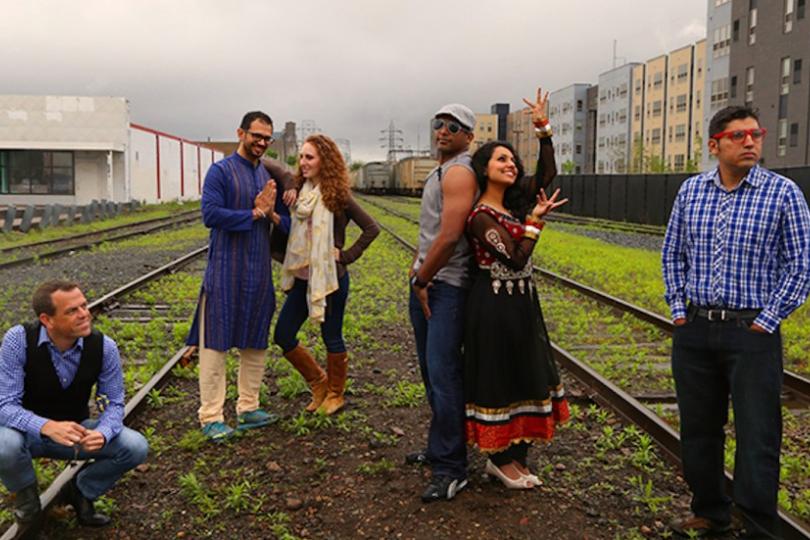Day 3 -- Fringe Recap

You all know by now that I’ve been trying hard not to be a Fringe Grinch this year, but when it came to picking a theme for a day at Fringe, my cynical side won. Today’s theme was the highly objective “stuff that might not suck” – in other words, the tried-and-true method of setting the bar low to pave the way for a pleasant surprise. I planned for a couple of serious plays by companies I had faith in, but I also braved the lines for some good old-fashioned sell-out extravaganzas, which may not be blazing any new trails, but are pretty much guaranteed not to suck.
And in fact, all four shows I saw did not suck! In fact, I would say that, despite having wildly different goals, all four succeeded at what they set out to do. I guess this is where Fringe reminds me why it’s so charming: it provides space for companies to take chances, and in this case, here are four shows where the chances pay off.
The Consolation is a world premiere that feels old-school in the best possible sense. Although ostensibly about the trial of ex-SS officer Adolf Eichmann, the play is actually a thought experiment into how one becomes a “desk murderer.” It’s written primarily as a Socratic dialogue, which would’ve been dreadful with a lesser actor or writer, but David Mann captures something troublingly human in his portrayal of Eichmann, playwright Ari Hoptman writes with finesse and energy. This is a play that never shies away from intellectualism, but avoids any hint of being pedantic.
Hoptman’s leap is in placing his examination of Eichmann alongside a re-enactment of the infamous Milgram experiment, where a test subject, “just following orders”, administered increasing levels of electrical shock to an unseen victim. This move turns a seemingly old-fashioned style into something innovative, because the comparison to Milgram’s test subject, whose distress at inflicting pain makes him a more sympathetic character, re-opens Eichmann’s actions to our scrutiny.
It’s a risky choice to use a Nazi to question a more universal human ability to be led into committing atrocities: I felt an intense urge to slam the door on any portrayal of Eichmann as even remotely normal, particularly given the difference in scale between the Milgram experiment and a death camp. But I think this revulsion toward what Hannah Arendt called “the banality of evil” is exactly the point of the play, forcing us to confront just how easy it is to keep quiet in the face of cruelty.
The Most Massive Woman Wins was another one I figured would be good, since it’s a remount of a popular 2009 production by Theatre Unbound. Madeleine George’s script focuses on body image and the myriad factors that go into people’s complex relationships with their bodies. (I say “people” because, although the show itself is about women, I can see many of these issues spanning genders.)
Like The Consolation, this was also stylistically old-school, weaving together four monologues about how each character ended up in a liposuction clinic. But the strength of the actresses makes it work, giving each monologue enough texture that the play feels like more than just a platform for awareness-raising.
The content is treated with some humor, but it’s a lot to handle in an hour: there are toxic parent-child and husband-wife relationships, control issues, and conflicts between deeply-held feminist ideals and engrained doubts about one’s desirability in the dating world. Any one of the four characters could have her own show, and any one of the actresses would’ve been up for the task. But there is so little theater that really engages with any of these issues that Most Massive Woman is practically obligated to go for breadth over depth (forgive the pun).
Edgar Allan moves us into the crowd-pleaser portion of my day. Edgar Allan is a dark musical comedy featuring a ukulele and performers based out of Brooklyn. I think it sold out (or close to it), because it’s the kind of quirky, well-performed show that many people come to Fringe for.
All of these things made me kind of want to hate it. But I didn’t, probably because some part of me identified with Katie Hartman’s performance as an 11 ¼-year-old boy who dreams of becoming a despot. And despite the inspiration from Poe, most of the show is a really hilarious portrayal of the awkwardness, petty rivalries, and weird rituals of middle-school friendships. My only qualm about the whole thing was that the deliciously dark and creepy twist didn’t come until right at the end – up to that point, it’s all the kind of ironic, hipster darkness (you know, the kind with owls) that you probably find in Brooklyn.
Spicy Masala Chai is an all-out Bollywood dance spectacular that packed both the main floor and the balcony of the Rarig Proscenium. This was unabashed fun, a totally two-dimensional East-meets-West plot that scaffolds a series of enthusiastic and well-choreographed dance numbers (also East-meets-West, adding some contemporary influences to traditional Bollywood-style dancing). It’s easy and light, but the dancing makes it all worth it – the dancers are good and the joy is infectious.
I’ve got to add that the gay romance sub-plot is adorable and heart-warming, especially given that it’s only recently that gay men have been portrayed in Bollywood at all.
Spicy Masala Chai highlights another thing Fringe is good at: getting massive audience turnout to see communities of non-professional (but excellent) dancers from ethnic minority groups. I love that there is a venue for these performers, and I love how much support there is for their shows. On the other hand, why do we only see this level of support at Fringe? Why don’t these endless Fringe lines translate into a deafening demand for more non-white representation in local theater and dance, including professional companies with the resources to take work like Spicy Masala Chai to the next level?
To conclude:
My day was a total success by all measures. I experienced a wide range of content and got to ponder some pretty heady topics, but ending on a lighter note kept me from burning myself out. None of the shows were flawless, but you’ve got to take Fringe shows for what they are, flaws and all – and most importantly, none of them sucked.
A few stray thoughts about biking and Fringe:
- Biking is definitely the best way to handle Fringe if you’re seeing multiple shows. Who wants to deal with parking and re-parking between venues?
- Knowing that, it would be really great if next year’s Fringe organizers helped venues provide more bike parking. Signposts got heavy use today.
- This leads me to gripe about how spread out many of the venues are. For those of us on two wheels, it just isn’t that fun to think about booking it between the West Bank and Uptown in the half-hour interval between shows, particularly if there’s a sell-out risk on the other end. I didn’t even look at the schedules of some venues, because I didn’t want to be zigzagging all over Minneapolis (or dealing with downtown traffic around the Illusion). I wonder how many shows lose audiences because the venues are so far apart. Would it level the playing field to center Fringe around the West Bank and Seward?




